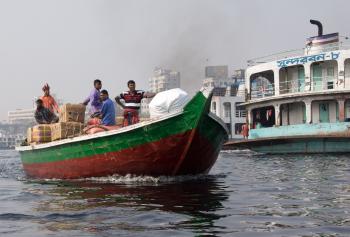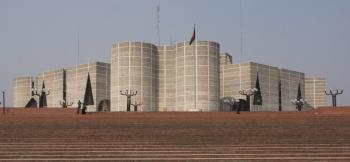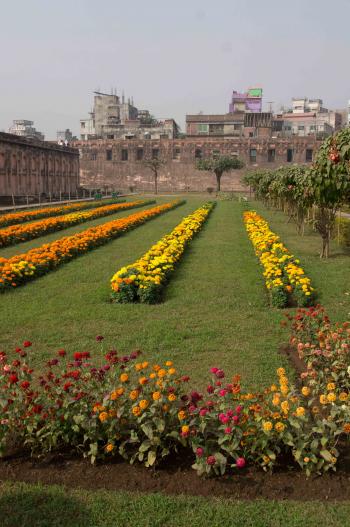Dhaka stopover and Nijhoom Tours
This item appears on page 28 of the January 2020 issue.
Dhaka stopover and Nijhoom Tours
En route to an escorted tour of Sri Lanka in January 2018, I paused for four nights in Dhaka, capital of Bangladesh. By stopping in a time zone 30 minutes later than Sri Lanka’s, I got a 4-day head start on adjusting to the local time before joining the tour.
My first day in Dhaka was reserved for rest. I left the hotel only for a brief walk in the early afternoon at what turned out to be the hour of the main Friday prayer. Although I had previously seen mosque floors and courtyards full of the faithful praying, this was the first time I saw an entire city street, from curb to curb for several blocks, full of people praying.
On the second and third days, I took tours that I had previously booked with Nijhoom Tours (House #06 [ground floor], Rd. 17, Nikunja 02, Khilkhet, Dhaka 1229, Bangladesh; phone +88 01799 002244, nijhoom.com).
On Saturday, I took their “Old Dhaka Tour” from 8 a.m. to 6 p.m. It encompassed nine destinations in the Old City and the new. Highlights for me were the Lalbagh Fort, the Star Mosque and the Port of Dhaka on the Buriganga River. Even at a nonpeak hour, an impressive number of boats were docked.
In addition to traveling by motor car and 3-wheeler pedicabs, we cruised the river for an hour in a small boat propelled by a man wielding a single paddle, introducing me to the importance of water transport in the low-lying (and flood-prone) joint delta of the Ganges and Brahmaputra rivers.
From 9:30 to 5 on Sunday, I took Nijhoom’s “National Assembly Tour,” which included the Bait Ur Rouf Mosque but focused on the iconic masterpiece designed by the architect Louis Kahn. In fact, it was the National Assembly Building that I had marveled at in a film biography of Kahn and which led me to visit Bangladesh.
Designed originally for the National Assembly of East Pakistan, its construction was halted in 1971 as Bangladesh became independent from Pakistan. Completed in 1982, the National Assembly Building now serves the Parliament of Bangladesh, and, once inside, we were escorted by a member of the Parliament staff. (Cameras and cell phones were not allowed inside.)
I found its interior even more stunning than the exterior, with views going upward several stories, including parallel and intersecting planes, rectangles and circles. Somehow, these all blended harmoniously.
For each of my tours, my expert guide was Nijhoom’s CEO, Raw Hasan. He appeared at my hotel with a comfortable vehicle and a competent driver. Our tours were unhurried, so I had time to photograph at will.
Hasan was unobtrusively responsive to my interests. He also showed concern for my comfort, turning down several electric-powered rickshaws to secure one powered by feet, for a smoother ride.
When I expressed an interest in trying Bangladeshi cooking, on the Dhaka-tour day Hasan took me to a restaurant. The next day, he ordered food in the members’ dining room in the National Assembly Building. (The luncheons were included.)
My hotel offered no Bangladeshi food, and Hasan told me this was the case with the other business hotels in Dhaka.
Despite being one of the world’s most populous countries, Bangladesh is relatively invisible as a tourist destination, owing in part to its relatively undeveloped tourist infrastructure and a grievous lack of self-promotion.
In Bangladesh, I didn’t have the “armed camp” feeling I’ve sometimes experienced in India or Pakistan, and I never felt threatened. I would not hesitate to return.
In addition to mosques, temples and other archaeological sites plus the huge metropolis of Dhaka with its 16 to 17 million inhabitants, Bangladesh has three UNESCO World Heritage Sites, including Sundarbans National Park, featuring mangroves and tigers.
Using Alaska Airlines miles, I had flown Emirates from Washington Dulles to Dhaka via Dubai. After negotiating Bangladesh’s visa-on-arrival process ($52 rather than $160 for a visa in advance), I sailed through Immigration and found my name on a sign held by a meet-and-greet person, who led me to baggage claim and to a waiting car to the hotel.
In predominantly Muslim Bangladesh, the weekend begins on Friday, so the Thursday-evening traffic was very congested. At one point, passengers kept disembarking from a bus ahead of us because they could get to their destinations faster by walking. The 5½-mile journey from airport to hotel took 2 hours 20 minutes; the return journey, mid-morning on Monday, took 22 minutes.
In booking my room, I could have reserved a guaranteed nonsmoking room on an individual hotel’s website at the rack rate or spent much less through an online travel agent, with a nonsmoking room requested but not guaranteed.
Fortunately, while searching on Expedia.com, I found the Innotel Business Boutique Hotel (House 23, Rd. 10, Block E; www.innotel
batonrouge.com), a completely nonsmoking property in the upscale, convenient Banani district. I prepaid $399 (with free cancellation) for four nights in a king room, including breakfast.
When I made this hotel booking, I received no confirmation of the reservation. Emails to the address on the hotel’s website went unanswered. When I sent a message via Expedia that included my email address, the hotel established direct email communication. They confirmed the existence of a reservation but neither the type of room nor the inclusion of breakfast. I printed a copy of Expedia’s reservation specification to present at check-in, if necessary. Fortunately, it wasn’t needed.
Emailing the hotel, I also booked a private transfer from the Dhaka airport for $18.75, one way.
The hotel turned out to be excellent in all respects save one: the room’s carpet appeared to be decades old and was badly stained. The housekeeping staff, however, did vacuum it daily. My quiet, “executive deluxe” room was well designed, well furnished and well lit. The staff was pleasant and attentive.
Although the hotel advertised two restaurants, it really offered one venue with two menus. The Casa Greek Restaurant offered Greek, Italian, Thai and Chinese dishes. The Rok Restaurant claimed to offer cooking at one’s table on a stone slab heated to 300°C.
When I ordered a seafood appetizer cooked this way, the server plunked the uncooked food and the hot stone (in a holder with side spaces for the cooked food) directly in front of me, not farther away as is typical for a Japanese hibachi. But I managed to avoid getting burned and cooked the food to taste.
I ate breakfasts and dinners in the hotel, and all were well prepared.
The tours I took with Nijhoom were fully priced but were well worth it. For a solo traveler, each one-day tour cost $130.
My experience with Nijhoom justified my decision to stop over in Dhaka.
PETER CALINGAERT
Chapel Hill, NC

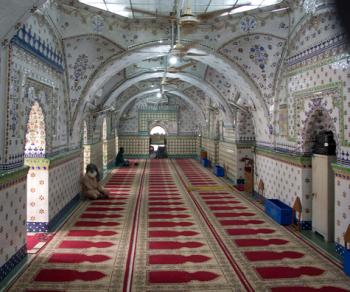
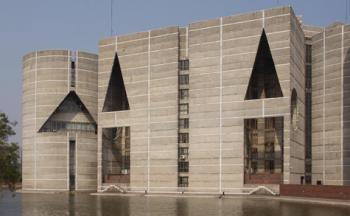
-itok=u83z162q.jpg)
